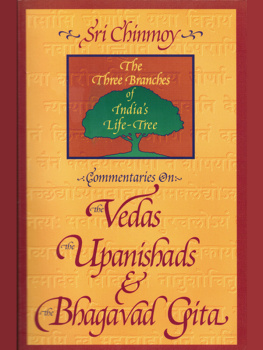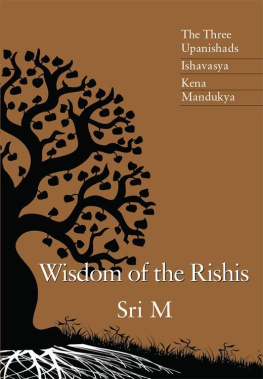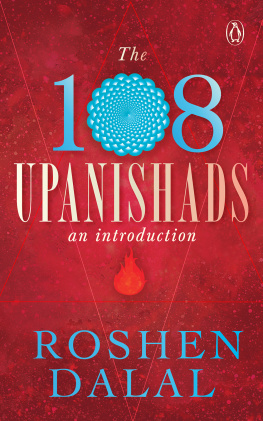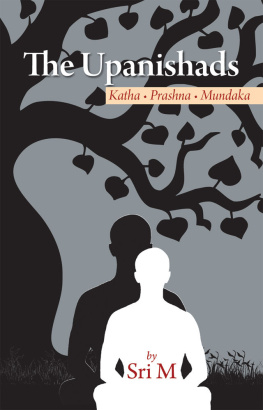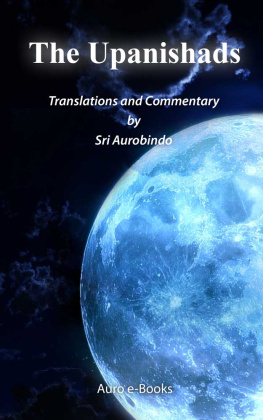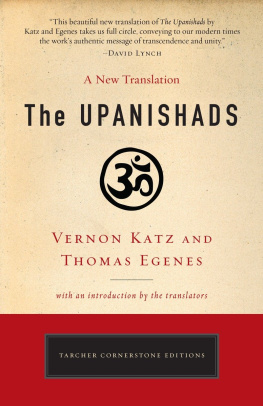THE
10 GREAT
UPANISHADS
THEIR ESSENCE REVEALED THROUGH SIMPLE
QUESTIONS AND ANSWERS

Dr. Giridhar Boray


THE 10 GREAT UPANISHADS
First published in India in 2016 by
Yogi Impressions Books Pvt. Ltd.
1711, Centre 1, World Trade Centre,
Cuffe Parade, Mumbai 400 005, India.
Website: www.yogiimpressions.com
First Edition, September 2016
Copyright 2016 by Dr. Giridhar Boray
All rights reserved. This book may not be reproduced in whole or in part, or transmitted in any form, without written permission from the publisher, except by a reviewer who may quote brief passages in a review; nor may any part of this book be reproduced, stored in a retrieval system, or transmitted in any form or by any means electronic, mechanical, photocopying, recording, or other, without written permission from the publisher.
ISBN 978-93-82742-50-0
Contents
FOREWORD
I am indebted to Dr. Giridhar Boray for this invitation to write a Foreword to his commentaries on the The 10 Great Upanishads. Dr. Boray has had a distinguished career as a technology adviser. Study of the Indian scriptures has been his special interest.
Upanishads mark a quintessential expression of the ultimate vision of Reality in mans eternal spiritual quest. The Upanishads says Dr. Radhakrishnan, represent a great chapter in the history of the human spirit and have dominated Indian philosophy, religion and life for 3000 years. Every subsequent religious movement has had to show itself to be in accord with their philosophical statements. Even doubting and denying spirits found in them anticipations of their hesitancies, misgivings and negations.
In the tradition of Vedanta, there are two main schools. One is the school of Vedantic Theism; the other the Vedantic Absolutism. There are many sampradayas (traditions) within each of them. The Upanishadic texts are invoked by either side. The epistemology of the non-dualistic standpoint is that problems are inexplicable on the level of relative experience. Only when this level is transcended is there any more the need to solve them. Vedantic Theism postulates one supreme God who creates, sustains, regulates, destroys the Universe and all within it. He is Sat, Chit, Ananda (truth, consciousness, bliss) with inexhaustible, infinite attributes and is transcendent and immanent unconditioned by space and time.
There are certain interpretations touching the apparent contradictions and antagonisms between the fundamental postulates of the liturgical and ritualistic expositions of the Samhitas (most ancient layer of text in the Vedas, consisting of mantras, hymns, prayers, etc.) in the Vedic literature on the one hand, and the purely philosophical positions of the Para Vidya (higher knowledge) in the Upanishads on the other. These are perceived by some as a revolt against, and reaction to, the Karma sections of the Samhitas and a spirit of denunciation implicit therein. The Meemamsakaras stand by the liturgical and ritualistic parts of the Vedas. These areas of great debate amongst scholars are at once prodigious and illuminating. The range and depth of these debates indicate the heights of Indian spiritual thought.
On many an occasion, Western philosophers seemed to claim that rigorous philosophy has been an exclusively Western phenomenon. But a professor of Philosophy at Harvard observed, By now it is pretty well recognized that Asia generally, and India in particular, has a philosophical heritage as rich, subtle, and variegated in its own ways as is that of the West. He added, Bertrand Russell has not stood out during his lifetime as an admirer of Asian thought but, long after his contributions to mathematical logic have been forgotten, his History of Western Philosophy may be remembered, not for its contents but for its title which, in the Western world, was the first to have the grace to recognize that Western philosophy is not synonymous with philosophy generally.
Western philosophy makes no distinction between the Mind and the Knowing self . Mind is more or less equated to consciousness. But traditional Indian philosophy clearly separates the Atman from the Mind.
Dr. Boray portrays in these essays the didactic spirit of the Upanishadic quest. The presentation of the Questions and Answers method in the Upanishadic texts exemplify the pariprasna (inquiry) technique of exchange of knowledge. Particularly interesting are examples of this from the Brihadaranyaka by the author. The present generation of Homo economicus, distanced from Indian spirituality, needs an introduction to the sublimity and lofty richness of the Upanishadic treasure. The learned author seems well-equipped to anticipate the doubts of the well-meaning modern generation as, indeed, he himself has spent successful professional time in the West.
He deserves our appreciation for his deep study of the message of the Upanishads, and for giving us the rich and rewarding results of his studies.
Bangalore
August 16, 2016
Padma Vibhushan
Justice M.N. Venkatachaliah
Honble Chief Justice (Retd.)
of Supreme Court of India
INTRODUCTION
As civilisations evolve over time, progress is increasingly measured in terms of material comforts with very little attention being paid to the overall quality of life. Modern medicine is singularly focussed on extending ones life without much regard to the maintenance or extension of inner happiness. In their eternal and unending quests for material riches, human beings have usurped the natural habitats of other species and destroyed the ecological balance resulting in catastrophic natural disasters with increased frequency. Accompanying these natural disasters are the battles within, where humans are increasingly resorting to substance abuse and similar self-destructive behaviour, as their search for a perfect life, full of unending material comforts and eternal youth, leads to emptiness.
Great civilisations before our times have not had the same levels of material comforts as we have access to, but have confronted issues such as the purpose of life, moral decline, etc. Their trials and travails have been well chronicled in scriptures such as the Upanishads. Humans have a tendency to look at history and classify time epochs as pre-historic, medieval, etc., which often are code words for periods dominated by subhuman behaviour among races.
There is a growing movement among modern-day intellectuals who proclaim that the advances in science and technology have resulted in faster means of communication and this, in turn, has resulted in a better and more intelligent world. This belief confuses information for knowledge. Even a cursory review of great scriptures such as the Vedas reveal the evolved thought processes and arguments that only a highly evolved race can put forth. Yet, all these occurred over thousands of years ago where sharing of information among people was limited. In fact, the Vedas predate invention of script and the concept of writing, and were orally transmitted by a teacher to a pupil. The Vedas and their components such as the Upanishads represent millions of years of evolved thought processes carried through generations, and are as relevant and fresh today as they have ever been.


